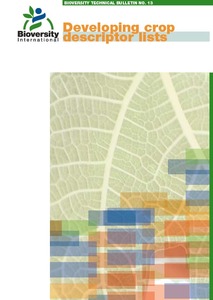Developing crop descriptor lists: guidelines for developers
The world faces a continual need to increase crop productivity, and to develop new varieties more adapted to changing environmental and biological challenges or to meet the evolving needs of local communities. To meet these needs and challenges, farmers and breeders not only must have access to a wide range of plant genetic resources but also must have access to the essential information about those plant genetic resources that will allow effective use to be made of them. These guidelines have been developed to assist genebank curators, breeders, plant scientists, national programmes, networks and users of genetic resources working with specific crops and gene pools to develop their own descriptor lists in order to characterize their material and make information available to others in a systematic and unambiguous form. In order to increase international exchange of material, a minimum element of uniformity is critical in data collection, recording, storage and retrieval. Developing standards for documentation and for exchanging information is essential for ensuring that the vast amount of data on crop species and varieties is available to countries to improve their capacity to store, manage and share information about biodiversity. The development of descriptor lists will assist in the systematic and objective recording and exchange of information such as passport, characterization and evaluation data, which in turn will increase utilization of germplasm so that people can make better use of biodiversity. Descriptors have been developed by Bioversity International and its predecessors, the International Board for Plant Genetic Resources (IBPGR) and the International Plant Genetic Resources Institute (IPGRI), for almost 100 crops in collaboration with scientists and international research organizations. However, there is a high demand for new descriptor lists to be developed for many species and new crops, including neglected crops, crops of regional or local importance, and forest species. The guidelines presented here have been produced based on experience gained from a wide range of crop studies and collaboration with many scientists, national programmes and crop networks. Various drafts of this Guide were circulated at different times to a number of Bioversity scientists and this publication is the consolidated result of those consultations (see Appendix I - Contributors). The development process was coordinated by Adriana Alercia, with scientific guidance from Dr Ramanatha Rao. These guidelines provide background information, set objectives and give insights into the structure, elements and methodology used by Bioversity to develop descriptor lists. They also provide a step-by-step checklist for defining characterization and evaluation descriptors, which can serve as a quick reference guide when developing new descriptor lists. Bioversity is thankful for the scientific advice and suggestions contributed by many scientists during the development of these guidelines.

